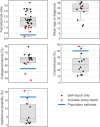Representativeness of autistic samples in studies recruiting through social media
- PMID: 35809003
- PMCID: PMC9541916
- DOI: 10.1002/aur.2777
Representativeness of autistic samples in studies recruiting through social media
Abstract
Survey-based research with recruitment through online channels is a convenient way to obtain large samples and has recently been increasingly used in autism research. However, sampling from online channels may be associated with a high risk of sampling bias causing findings not to be generalizable to the autism population. Here we examined autism studies that have sampled on social media for markers of sampling bias. Most samples showed one or more indicators of sampling bias, in the form of reversed sex ratio, higher employment rates, higher education level, lower fraction of individuals with intellectual disability, and later age of diagnosis than would be expected when comparing with for example population study results from published research. Findings from many of the included studies are therefore difficult to generalize to the broader autism population. Suggestions for how research strategies may be adapted to address some of the problems are discussed. LAY SUMMARY: Online surveys offer a convenient way to recruit large numbers of participants for autism research. However, the resulting samples may not fully reflect the autism population. Here we investigated the samples of 36 autism studies that recruited participants online and found that the demographic composition tended to deviate from what has been reported about the autism population in previous research. The results may thus not be generalizable to autism in general.
Keywords: autism; online recruitment; sampling bias; selection bias.
© 2022 The Authors. Autism Research published by International Society for Autism Research and Wiley Periodicals LLC.
Conflict of interest statement
Kamilla Woznica Miskowiak declares having received consultancy fees from Lundbeck A/S and Janssen‐Cilag A/S in the past 3 years. Eya‐Mist Rødgaard, Kristian Jensen, and Laurent Mottron declare no conflicts of interest.
Figures


Similar articles
-
Explicit Associations with Autism and Disability.Autism Adulthood. 2019 Dec 1;1(4):258-267. doi: 10.1089/aut.2019.0028. Epub 2019 Dec 13. Autism Adulthood. 2019. PMID: 36601324 Free PMC article.
-
Unmet health care needs and health care quality in youth with autism spectrum disorder with and without intellectual disability.Autism. 2021 Nov;25(8):2199-2208. doi: 10.1177/13623613211014721. Epub 2021 May 24. Autism. 2021. PMID: 34030515
-
Empathizing, systemizing, empathizing-systemizing difference and their association with autistic traits in children with autism spectrum disorder, with and without intellectual disability.Autism Res. 2022 Jul;15(7):1348-1357. doi: 10.1002/aur.2766. Epub 2022 Jun 19. Autism Res. 2022. PMID: 35719032
-
Autism presentation in female and Black populations: Examining the roles of identity, theory, and systemic inequalities.Autism. 2022 Nov;26(8):1931-1946. doi: 10.1177/13623613221113501. Epub 2022 Jul 28. Autism. 2022. PMID: 35899909 Review.
-
[Prevalence of pervasive developmental disorders. A review].Encephale. 2009 Feb;35(1):36-42. doi: 10.1016/j.encep.2007.12.011. Epub 2008 Sep 23. Encephale. 2009. PMID: 19250992 Review. French.
Cited by
-
Evaluating measures to assess loneliness in autistic adults.Autism. 2024 Aug;28(8):1959-1971. doi: 10.1177/13623613231217056. Epub 2023 Dec 25. Autism. 2024. PMID: 38143433 Free PMC article.
-
Food and Nutrition in Autistic Adults: Knowledge Gaps and Future Perspectives.Nutrients. 2025 Apr 26;17(9):1456. doi: 10.3390/nu17091456. Nutrients. 2025. PMID: 40362765 Free PMC article. Review.
-
Individual differences in autism-like traits are associated with reduced goal emulation in a computational model of observational learning.Nat Ment Health. 2024 Sep;2(9):1032-1044. doi: 10.1038/s44220-024-00287-1. Epub 2024 Jul 10. Nat Ment Health. 2024. PMID: 39734327 Free PMC article.
-
Assessing Restricted and Repetitive Behaviours in Online-Sampled Autistic and Non-autistic Individuals: Factor Structure of the Repetitive Behaviours Questionnaire for Adults (RBQ-2A).J Autism Dev Disord. 2024 Jun;54(6):2138-2147. doi: 10.1007/s10803-023-05977-w. Epub 2023 Apr 13. J Autism Dev Disord. 2024. PMID: 37052863 Free PMC article.
-
Brief Report: Longitudinal Role of Coping Strategies on Mental Health Outcomes in Autistic Youth and Adults.J Autism Dev Disord. 2025 Mar;55(3):1146-1155. doi: 10.1007/s10803-023-05953-4. Epub 2023 Apr 5. J Autism Dev Disord. 2025. PMID: 37017862
References
-
- Arnold, S. , Foley, K. R. , Hwang, Y. I. , Richdale, A. L. , Uljarevic, M. , Lawson, L. P. , Cai, R. Y. , Falkmer, T. , Falkmer, M. , Lennox, N. G. , Urbanowicz, A. , & Trollor, J. (2019). Cohort profile: The Australian longitudinal study of adults with autism (ALSAA). BMJ Open, 9(12), 1–16. 10.1136/bmjopen-2019-030798 - DOI - PMC - PubMed
-
- Baltar, F. , & Brunet, I. (2012). Social research 2.0: Virtual snowball sampling method using Facebook. Internet Research, 22(1), 57–74. 10.1108/10662241211199960 - DOI

